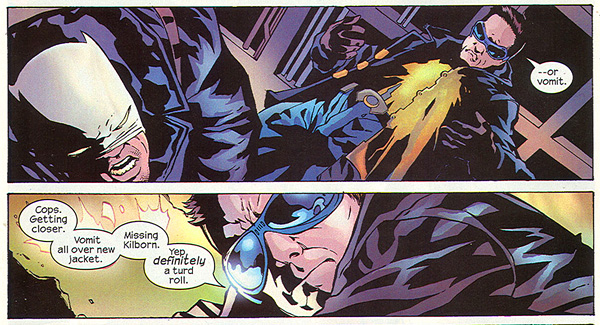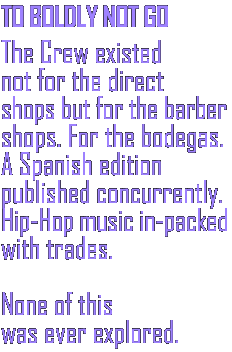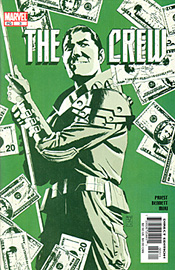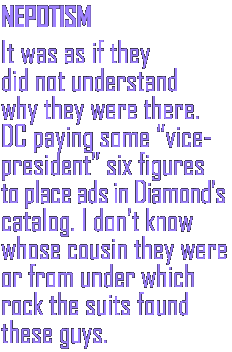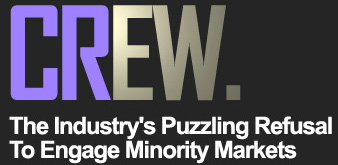
I was absolutely furious when they cancelled it.
This was a really good book. Joe Bennett and Danny Miki (with
Avalon Studios on color) did amazing work. Bennett brought the
White Tiger (formerly The Black Panther) to life. Kasper Cole,
plagued by incredibly poor artist casting on Black Panther,
zoomed to life in The Crew, with Joe Bennett showing us what
we’d been missing in the pedestrian, lackluster Panther art. In
his new identity as The White Tiger, Cole simply bloomed under
Bennett’s direction, as did Danny Vincent (Junta), also a
Panther transplant. I gave James “Rhodey” Rhodes a complex edge
which I was eager to explore, and we introduced Marvel’s first
black Muslim super-hero in “Josiah X,” aka Justice. At Tom’s
suggestion, we took our time and rolled out each character
individually with four showcase issues, collapsing the
storylines into one with issue #4 as the boys discover one
another. It was, for me, a rich experience in character
development, and both Bennett and Miki—both of whom were jazzed
to be on then book—amazed me every issue. So, of course, Marvel
cancelled it.
My biggest disappointment with The Crew was with Marvel’s
marketing department. I never understood any of those people. I
don’t know whose cousin they were or from under which rock the
suits found these guys and brought them in, but, at least back
in my day, these were some of the most inept, unimaginative,
stone-headed people I’d ever seen. It seemed to me that Marvel
Creative would come up with these great ideas, and then the
marketing department would blow it. All along the development
process, we, in fact, knew they would blow it. These guys worked
in advertising or for, I don’t know, Wall Street Week or
whatever, but they would drop the ball and drop it hard every
single time. There was a contentious spirit between creative and
marketing at both DC and Marvel, with, my take on it, the
marketing guys looking at the creative guys like children, and
the creative guys typically upset that long days of hard work
ended up for nothing because marketing would not get off its
duff and actually go sell comic books.
It was as if they did not understand why they were there. That’s
how bad these people were at their jobs. But Paul Levitz and
Mike Hobson kept these men and women at their desks even as they
watched the numbers dwindle. I cannot say with any authority
what went wrong or right with Milestone because both Dwayne
McDuffie and Dick Giordano kept me out of that loop—which was a
really dumb thing to do considering I was DC’s liaison to
Milestone Media—but my instinct tells me the contentious
atmosphere between Milestone and DC’s incredibly inept,
incompetent and lame marketing department likely put the
experiment on a path. The atmosphere was so poisoned, the
marketing guys disliked the Milestone guys so much, it seemed to
me that marketing would do the bare minimum necessary to promote
Milestone. To my knowledge there was little or no effort made to
expand the market beyond traditional comic shops—which aren’t
terribly popular with the brothers—and get into distribution
chains for ethnic community centers like barber and beauty
shops, record store chains and boutiques. I know, for a fact,
exploring new distribution avenues was a prime motivator for DC
to invest in Milestone, and Milestone President Derek T. Dingle
had initially laid out an array of stratagem for breaking comics
into new distribution channels.
DC Marketing did none of that. They bundled up Milestone and fed
it to the normal direct outlets. They put an ad in Diamond’s
catalog. And On The Sabbath Day They Rested. A monkey could have
done that. The entire point of Milestone wasn’t to lure black
kids into comics shops but was to broaden DC’s distribution
beyond the narrowing funnel of the direct shops and loosen the
stranglehold Diamond had on comics distribution. I have to
assume DC Marketing missed that memo somehow or that calamitous
things went on behind my back because, from what I could tell,
there was no effort—none—made to move Milestone past Diamond and
the direct shops.
Alive:: Bennett, Miki & Avalon breathe new life into the would-be Panther, Kasper Cole as The White Tiger.
White Guys Talking To White Guys About Selling To White Guys:
Latino U.S. Market: $750 Billion. Black U.S. Market: $892
Billion.
Marvel and DC Minority-Targeted Publishing Lines: 0.
With The Crew, my pitch to Marvel was precisely the same. The
Crew existed not for the direct shops but for the barber shops.
For the bodegas. I suggested a Spanish edition published
concurrently. Hip-Hop music in-packed with trades. I had a deal
in principle with a major online distributor to pay for the CDs
in exchange for including their catalog and content on the CD.
Friends like Reginald Hudlin were willing to help get us
connected with Vibe and XXL Magazines and explore joint ventures
with Johnson Publishing. So far as I know, none of that was
done. Marvel marketing lifted not one finger for The Crew, saw
no potential in the series. Beyond Tom Brevoort’s office there
was only an eye roll. Marvel Comics, run by an Hispanic EIC and
a close friend of mine, turned blind eye and deaf ear to a rich
opportunity. Latino and African American markets are worth
hundreds of billions of dollars in the U.S. So far as I know,
both majors have stupidly and arrogantly dismissed those
markets, along with the multi-billion dollar Christian/Evangelical market, which
virtually no major and precious few indys will touch—like
they’re afraid of all that cash waiting to be collected. That’s
money, lying all over the floor, and these guys are too lazy to
pick it up. Mainstream comics have long had an arrogant Anglo
point of view. All of Marvel’s films are Anglo-centric. At least
the Batman film people were savvy enough to put Morgan Freeman
front and center, while the Iron Man franchise has utterly
wasted both Terrence Howard and Don Cheadle. This sends a
message to minority communities, whether or not DC or Marvel
realize it.
DC staffers seemed, to me, hostile toward and perhaps jealous of
Milestone. Marvel was not overtly hostile to The Crew, but, from
my chair, they wrote it off as another failed Priest project. As
many fans did, it felt to me as if Marvel had judged the book
entirely from a racial point of view. Race First. Having not
read a single word of this comic, it was branded a “ghetto” book
and cancelled before the first issue arrived in stores. This
after an arduous, months-long development process that just wore
me out. There should be some rule that, if you’re going to put a
writer through the ringer for months at a clip, you need to
commit to the project for at least a year. You have to give it
time to find an audience.
Only, The Crew’s audience was not in comics shops (see sidebar).
Write this down someplace: White People Don’t Buy Black Comics.
Don’t clutch your chest. Sure, there are exceptions to that
rule, but in the history of modern comic books, black characters
have never, ever, sold as well as white characters. A series
being branded a “black” book is (or, at least was) the kiss of
death. I never expected The Crew to do well in comic shops
through Diamond. I expected Marvel Marketing to get off their
butts and at least make a phone call or two. I had spoken to a
number of people anxious to see this book and to explore ways to
co-op it; perhaps an in-pack with XXL or Vibe. I put together a
CD of original rap and hip-hop from local artists. There’s tons
of the stuff, free, theses guys were excited about being part of
a Marvel Comic. Thousands of barber shops across the country are
where minority kids go every other week: why isn’t there a
comics rack in there? Why has both DC and Marvel marketing
completely ignored the minority market for seventy-five years?
Because they’re stupid. It’s not even racism, it’s stupidity.
Entire departments at these places needed to be fired and, by
God, had anybody ever been stupid enough to name me EIC, that
would have been the first thing I’d do. Look, you’re either a
businessman or you’re a fanboy. It’s tough o be both. A
businessman sells. He doesn’t just sell to whites. He doesn’t
just sell what he likes. A businessman sells both Coke and
Pepsi. A businessman looks for any avenue available to get his
product out there. I could be wrong, and I’ll gleefully admit so
if someone wants to set me straight. But in twelve years behind
desks at Marvel and DC, what I saw from the sales force were
white guys talking to white guys about selling to white guys.
They were woefully inept at connecting to women or minorities,
and, to my knowledge, have never developed strong relationships
in black or Latino markets.
An Auspicious Start:: The White Tiger Ralphs up lunch on Danny "Junta" Vincent.
It's Got Legs
The Crew was custom-tailored for Marvel’s marketing department.
It could have been—and could be today in trade paperback—a trial
balloon used to explore new markets. The one story arc, “Big
Trouble In Little Mogadishu,” has no specific bearing on current
continuity (whatever that may be), and the people Marvel would
be trying to reach with this don’t read comics and wouldn’t have
any idea about continuity anyway. I wrote this series eight
years ago. Marvel has done absolutely nothing with it. They sent
it to Diamond as part of a flood of poorly-planned new launches,
most of which were summarily cancelled. And, despite my routine
pleas to the contrary, Marvel has not shown the least interest
in packaging the series and approaching black and Latino
channels for distribution.
The abrupt and premature cancellation of The Crew, which I was
terribly invested in and extremely proud of, was, for me, the
death knell. I threw up my hands, that’s it for me and comics.
Had Tom not offered me Captain America and The Falcon, The Crew
would have been my last published comics work. It’s not the art
form I despise so much, it’s the idiocy of the people
controlling it. Billions of dollars lying on the floor. So many
bills we’re slipping in them as we walk past trying to sell the
same old crap to the same old people.
Christopher J. Priest
21 September 2011
Home | Blog | Projects | Comics | Rants | Music | Video | Christian Site | Contact
The CRew Copyright © 2011 Marvel Productions. All Rights Reserved.
Sample/Edit of Fallien by Jemong Gaulden. Performed by JemondG Featuring Exel and Steve Frazier. Copyright © 2011 UMAT Productions.
All Rights Reserved. Used By Permission.
Text Copyright © 2011 Lamercie Park. All Rights Reserved.
TOP OF PAGE


